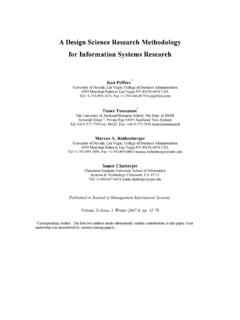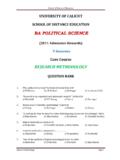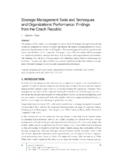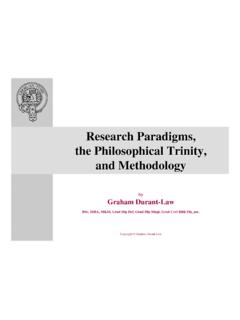Transcription of A new model of strategic thinking competency - …
1 The current issue and full text archive of this journal is available at JSMA. 6,3. A new model of strategic thinking competency Polboon Nuntamanop School of Management, Asian Institute of Technology, Pathumtani, Thailand 242. Ilkka Kauranen Industrial Engineering and Management, Aalto University, Aalto, Finland, and Barbara Igel School of Management, Asian Institute of Technology, Pathumtani, Thailand Abstract Purpose This paper seeks to present new insights into strategic thinking , proposing a model of strategic thinking competency . Design/methodology/approach To find new knowledge, the research applies the Straussian grounded theory research method using multiple sources and techniques of data inquiry: in-depth interviews, observations, literature review, and related published documents.
2 The sample cases are business leaders of leading high growth companies in their respective markets, representing eleven different industries in Thailand. Findings Among many new knowledge, the study found seven characteristics of strategic thinking that impacts strategy formulation, strategic actions, and business performance: conceptual thinking ability, visionary thinking , analytical thinking ability, synthesizing ability, objectivity, creativity, and learning ability. This set of abilities and skilled are termed strategic thinking competency . Research limitations/implications In-depth interview data inquiry method has potential bias towards positive information. Although the study covers many industries, the small number of sample cases limits degree of generalization.
3 A constraint of qualitative research method in interpretation of the results is reduced by comparing empirical results to the literature. Practical implications The strategic thinking competency model offers a framework for developing strategic thinking of business leaders and managers which contributes to better strategy and better business performance. Human resource developers may apply the model for designing training programs to develop better strategic thinkers. Social implications Better strategic thinking could help improving efficiency and effectiveness of business and general management. Originality/value The study introduces a model of strategic thinking competency with seven characteristics, proposing a new way of defining strategic thinking . Keywords strategic thinking , strategic management, Strategy development, Management, competency , Business administration, Leadership Paper type Research paper Introduction strategic thinking is important for strategy development and strategic management (Andrews, 1980; Porter, 1987; Zabriskie and Huellmantel, 1991; Mintzberg, 1994a, b.)
4 Mintzberg et al., 1998a, b; Liedtka, 1998; Macmillan and Tampoe, 2000; Saloner et al., 2001; Bonn, 2001; Graetz, 2002; Abraham, 2005), and contributes to corporate outputs, and profitability (Bowman and Helfat, 2001). The relationship between strategy and performance is confirmed by the longitudinal case study of McAdam and Bailie (2002). Journal of Strategy and Management Vol. 6 No. 3, 2013. on business performance measures and impact on strategy. In addition, Kraus et al. pp. 242-264 (2006), in their study of strategic planning in small enterprises, conclude that r Emerald Group Publishing Limited 1755-425X. formalization in strategic planning of firms is positively related to growth of the firm. DOI A recent extensive literature review by Steptoe-Warren et al.
5 (2011) found that strategic competencies are important to strategic management yet there is no agreement within strategic the literature on what those competencies are. thinking Despite a wide consensus on the importance of strategic thinking to business performance, an extensive literature review has found few studies that define what competency strategic thinking is or empirically verify how strategies and strategic actions business leaders in practice take relate to strategic thinking . To gain new insights, the study applies the Straussian grounded theory research 243. approach, using in-depth interviews as the primary source of empirical data. This grounded-theory based study aims to find new knowledge about strategic thinking , answering a research question what constitute strategic thinking that impacts strategies leading to successful business, by empirically studying business actions, applied strategies, and behaviors and thoughts of successful business leaders.
6 The empirical data were compared to the literature during the data analyzing and synthesizing stage. This paper proposes a model of strategic thinking competency , presenting new insights about characteristics of strategic thinking that impact strategies and business performance. This new model offers a new way of looking at strategic thinking as a competency of business leaders, which has not been found in existing literature. The result of the study can be used as a framework for developing strategic thinking of individuals, through self-development or human resource development programs. strategic thinkers could help the organization to better respond to the challenges of the changing business environment (Tavakoli and Lawton, 2005). The paper may trigger further studies about the application of strategic thinking or about other competencies of business leaders which impact business performance.
7 Literature review This study is based on the basic concept of strategic management. strategic management is a set of decisions and actions that result in the formulation and implementation of plans designed to achieve an organization's objectives (Pearce and Robinson, 2000), and relates to business performance (Porter, 1987; Mintzberg, 1994a, b; McAdam and Bailie, 2002). To allow new insights to emerge, the grounded- theory-based study does not assume any theory in strategic thinking for the study (Strauss and Corbin, 1998; Creswell, 1998). The different concepts and theories about strategic management from the literature reviews provide inputs for designing interviews and analyzing the empirical data. strategic management process strategic management is defined as a process of building capabilities that allows a firm to create value for customers, shareholders, and society (Nag et al.)
8 , 2007). Detailed process is a way to achieve desired strategic outcomes (Whittington, 1996;. Jarzabkowski et al., 2007). Most general models of strategic management are similar (Feurer and Chaharbaghi, 1997), they consist of: strategic vision formation; information analysis; objective setting; strategy formulation; strategy implementation; and performance evaluation (Thompson and Strickland, 1996; Pearce and Robinson, 2000;. Macmillan and Tampoe, 2000; Saloner et al., 2001). The general strategic management process is used as a framework to empirically study the links between business performances, business growth in this case, and strategic thinking which takes place during the process. The general strategic management process is illustrated in Figure 1. JSMA Business 6,3 Vision formation performance evaluation Internal information Information (company analysis resources).
9 244 Objective setting External information Strategy (industry and formulation competition). Figure 1. Strategy General strategic implementation and evaluation management process Strategy formulation Strategy formulation is a continuous process involving different levels of decisions (Pettigrew, 1977, p. 49). This study recognizes different views of Quinn (1980a, b) and Lindblom (1959, 1979) on incrementalism, which declares that strategies are logically incremental, emerging from an iterative process rather than through formulations of total strategies; and views of Whittington (1996) which proposes a concept of strategy-as-practice viewing strategy formulation at the micro level as an on-going activity. An empirical study by Miller (1987) about strategy making and implication of performance found that innovative and successful firms have the strongest structure- and-strategy relationships.
10 Based on different views of strategy formulation found in the literature review, this empirical research studied the behaviors and thoughts of business leaders: how they determine the basic goals and objectives of their companies, how they adopt courses of action, and how they allocate resources necessary for carrying out these goals (Chandler, 1962 in Feurer and Chaharbaghi, 1997). The study also aims to learn more about how the business leaders identify opportunities and risks, how they determine the company's resources, the roles of their personal values, and how they acknowledge the non-economic responsibilities towards the society (Andrews, 1980). This study also acknowledges different views of creating corporate strategy; the market-based view, and the resource-based view (RBV), which shares a common aim to maximize the performance of an organization (Feurer and Chaharbaghi, 1997, p.)







